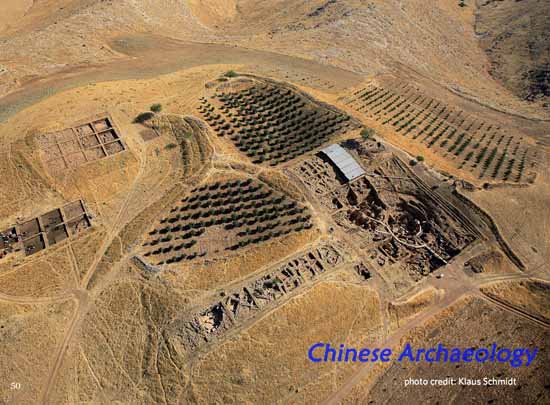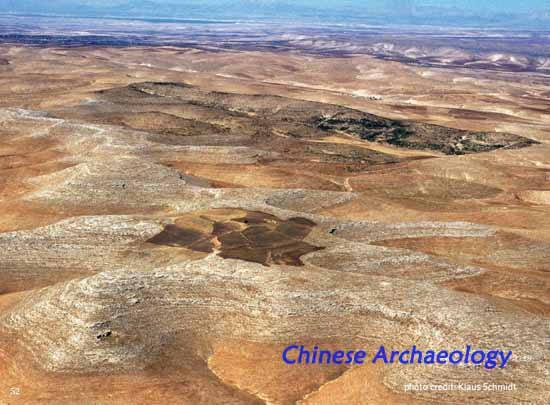Gobekli Tepe (Southeastern Turkey) – Megalithic Sanctuaries and the "Neolithic Revolution"
Located on a mountain ridge near the modern town of Şanlıurfa in south-eastern Turkey, Göbekli Tepe is clearly visible from afar, overlooking the surrounding plains, in a region referred to as Upper Mesopotamia, which also includes northern Syria and northern Iraq. It was in this region during the 10th and 9th millennium cal BC – contemporaneous with Göbekli Tepe – that the transition from hunting-gathering societies to food producing early village farming communities took place.
This transition began immediately after the end of the last Ice Age, and much earlier than in any other regions of the world. All over the globe the transitional period from the late glacial period to the early Holocene is characterized by fundamental changes in the environment. These changes are documented, for example, in Greenland Ice core records. At a more regional level, pollen assemblages from marine, lacustrine and terrestrial cores provide detailed information on climatic development, i.e. for particular geographic areas. In general a first phase of climatic amelioration (ca. 12.700 – 10.700 cal BC) is followed by a final cool period, the so called Younger Dryas (c. 10.700 – 9.600 cal BC) while more stable interglacial conditions became established in the subsequent early Holocene.

Some of the most fundamental questions that have been challenging archaeologists for generations are: Why did people first abandon hunting-gatherer lifeways, preferring instead to domesticate plants and animals? Is there a connection between the documented climatic change and the rise of early village farming communities? In other words, why did the Neolithic Revolution take place? We must also ask why such developments happened exactly here, i.e. between Euphrates and Tigris, and not elsewhere, e.g. in the Danube region of Europe or in the Nile valley in Northern Africa? Finally, why did this development not occur earlier, prior to the Holocene, e.g. during the great period of the ice age hunters?
Remarkable new discoveries at Göbekli Tepe have pushed this discussion into a whole different light, quite removed from earlier formulated opinions on this issue. The distinct character of the site is underlined by its architecture and diverse set of objects of art, ranging from small stone figurines, through sculptures and statues of men and animals, to large decorated megaliths. However, Göbekli Tepe is not a settlement; it comprises several megalithic sanctuaries with menhir-like monolithic T-shaped pillars, each weighing several tons. The pillars are usually arranged in circles and are connected by walls, defining the inner and outer space of the enclosures. In the centre there are always two huge freestanding pillars. The meaning of the T-shape can be interpreted easily as anthropomorphic, as some of the pillars have arms and hands depicted in flat relief, undoubtedly those of humans. The head is represented by the cross of the T-shape; the pillar’s shaft is the body. Differentiation of sex was evidently not intended. It is also clear that the minimalistic form of representation was intentional, because more or less naturalistic sculptures and reliefs of animals and humans also exist. These could be apotropaic, placed on the walls or on the pillars, at the same time providing sufficient proof of the artist’s ability to produce such works.

Although the identities of the anthropomorphic pillars still evade us, we hope that progress can be made through continued study of this new and previously unexpected iconographical world of the Stone Age. Perhaps they represent mythical ancestors, or demons, or even the first Gods ever depicted in a monumental way in the history of mankind. Before the discovery of Göbekli Tepe there was a common belief that the societies at the beginning of the Neolithic were organized into small bands of hunter-gatherers and that the first complex religious practices were developed by groups that had already mastered agriculture. When we look at the new data from the discoveries at Göbekli Tepe, we have no doubt that the amount of time, energy, craftsmanship, and man-power necessary for the construction and maintenance of this site is indicative of a complex, hierarchical social organization and a division of labor involving large numbers of people. Feasting was presumably the immediate reason for the gathering of hundreds of individuals at the site. Seen from this perspective, the emergence of food production in the course of the 10th and 9th millennium may represent the outcome of a series of innovations and adjustments to the subsistence patterns to meet and secure the energy demands of these large sedentary communities. A major driving force behind the process of plant and animal domestication may have been provided by the spiritual concepts of these peoples, in particular the investment of effort in the materialization of their complex immaterial world – of which monumental architecture was an important part.

Excavations at Göbekli Tepe are a research project of the German Archaeological Institute, supported by the German Research Foundation. The bio-archaeological component of the project is in cooperation with Joris Peters and his team from Munich University. The John F. Templeton Foundation is supporting an associated project entitled “Our Place – our place in the World”, in cooperation with Trevor Watkins. We are extremely grateful to the General Directorate of Antiquities in Ankara for the permission to work at such an important site and to the European Community, the Global Heritage Fund, the Kaplan Fund, the Koç Foundation and FREDDY S.p.A. who are generously financing canopies for the protection and conservation of excavated structures.
Klaus Schmidt (German Archaeological Institute)
Biographical Sketch
Dr. Klaus Schmidt is a German archaeologist and senior scientific consultant for Prehistoric Archaeology of the Near East in the Orient Department of the German Archaeological Institute in Berlin. Dr. Schmidt had directed the excavations at Göbekli Tepe, Turkey, since 1995. From 1974-1983, Klaus Schmidt studied Prehistoric Archaeology at the Universities of Erlangen-Nürnberg and Heidelberg, with a minor in Geology, Palaeontology and Classical Archaeology. In 1983 he earned his Ph.D. from the University of Heidelberg with a thesis "Die lithischen Kleinfunde vom Norşuntepe" (The lithic fnds of Norşuntepe). Between 1983-1995 he worked with different projects at the German Archaeological Institute and at the University of Heidelberg in Egypt and Turkey. In 1999 he was inaugurated at the University of Erlangen-Nürnberg, where he has been a private lecturer since 2000. In 2007 he became adjunct professor. Since 2001 he is senior scientific consultant for Prehistoric Archaeology in the Orient Department at the German Archaeological Institute in Berlin. Since 2002 he is co-director of the excavations in Tall Hujayrat al-Ghuzlan near Aqaba (Jordan).

